Many are drawn to a minimalist lifestyle today. Tiny house living combines simplicity with function. It shows that even small spaces can be stylish and useful.
This small home shows how smart design can make a limited space a dream. With tiny homes becoming more popular, people find joy in living simply. They focus on what’s important and enjoy the freedom it brings.
Key Takeaways
- Embracing minimalist living can simplify your life.
- Tiny homes offer a unique blend of style and functionality.
- Smart design is key to maximizing small spaces.
- Living with less can lead to a more fulfilling life.
- The tiny house movement is gaining popularity worldwide.
The Tiny House Movement: A Modern Lifestyle Revolution
The tiny house movement is changing how we see home and living. It’s not just about smaller homes. It’s about living simply, sustainably, and freely.
Origins and Evolution of the Movement
The tiny house movement started in the 1960s and 1970s. It was influenced by counterculture and environmental movements. But it really took off in the early 2000s.
Things like economic troubles, environmental worries, and a wish for simpler lives helped it grow. Key people and events have shaped the movement. This includes Henry David Thoreau and today’s tiny house builders and fans.
Key Principles of Minimalist Living
The tiny house movement is all about minimalist living. This means:
- Reducing what we consume and waste
- Making our living spaces simpler
- Focus on what really matters
- Living in a way that’s good for the planet
By living with less, people find more freedom and happiness. This matches the movement’s values of simplicity and caring for the planet.
Why People Are Embracing Tiny House Living
Tiny house living brings together financial, environmental, and mental health perks. It’s a way to simplify life and lessen our impact on the planet. This movement is becoming more popular as people seek a simpler way of living.
Financial Freedom Through Downsizing
One big reason for tiny house living is financial freedom through downsizing. It cuts down on costs like mortgage, utilities, and upkeep. This lets people save money for other things they want to do. Downsizing also means less stuff and more organization.
Environmental Benefits and Reduced Carbon Footprint
Tiny houses are environmentally friendly because they’re smaller. They need fewer resources to build and keep up. They also use less energy for heating, cooling, and lighting. This makes tiny houses a greener choice for living.
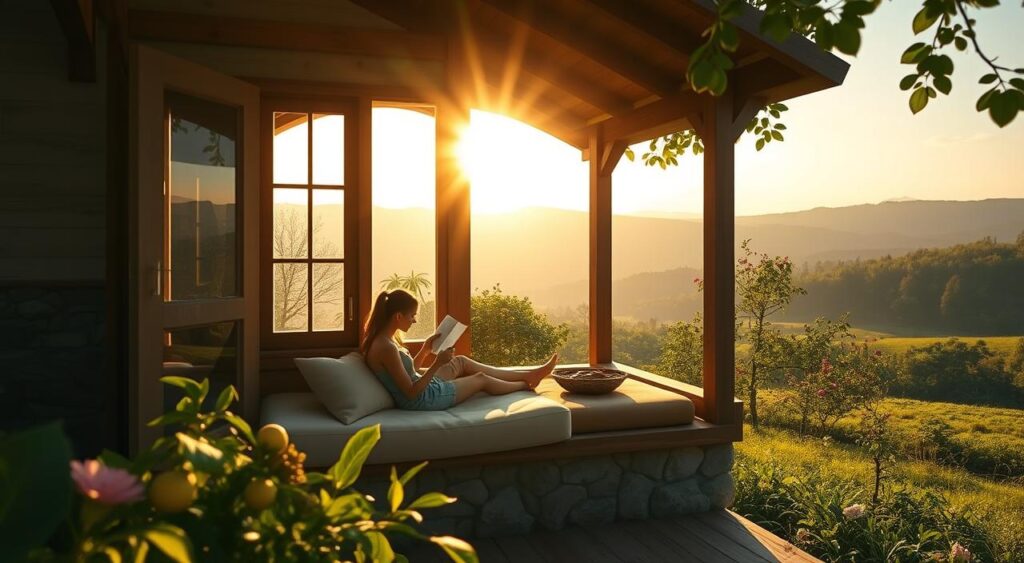
Mental Health Advantages of Simplified Living
Living in a tiny house can also boost your mental health. It reduces clutter and distractions. This lets people focus on what’s truly important. It can bring calm and well-being, making life more organized and productive.
In summary, tiny house living offers many benefits. It’s good for your wallet, the planet, and your mind. As more people enjoy the benefits of compact living, the tiny house movement will keep growing.
Assessing If Tiny House Living Is Right for You
Before you start tiny house living, think if it’s for you. Look at different parts of your life to see if it’s a good choice.
Lifestyle Compatibility Assessment
Think about your daily habits and what you like. Ask if you’re okay with less space and fewer things. Tiny house living needs you to be flexible and adaptable.
Family Considerations and Dynamics
If you have a family, think about their needs. Consider your family’s size, your kids’ ages, and everyone’s needs. It’s important to see how your family might adjust to small house living.
Career and Location Flexibility
Your job and how flexible it is matter a lot. Think if you can work from home or if you must be somewhere specific. Location flexibility helps you live where you want, not just for work.
By looking at these points, you can decide if tiny house living is for you.
Step 1: Creating Your Tiny House Vision and Plan
Before starting tiny house living, you need a solid plan. This plan should cover your needs, budget, and timeline. It’s the foundation for a successful tiny house project.
Defining Your Non-Negotiable Needs
Knowing what you must have in your tiny house is key. Think about how many people will live there, space for hobbies or work, and essential amenities. Prioritizing your needs makes your tiny house functional and cozy.
Setting a Realistic Budget
Having a realistic budget is essential for your tiny house. It includes the house’s cost, land, utilities, and furniture. A good budget prevents financial stress and keeps your project going.
| Budget Component | Estimated Cost |
|---|---|
| Tiny House Construction | $30,000 – $60,000 |
| Land Acquisition | $10,000 – $50,000 |
| Utilities and Furnishings | $5,000 – $15,000 |
Establishing Your Timeline
Having a timeline for your tiny house project is important. It helps you track progress and stay on track. You’ll set both short-term and long-term goals.
Short-Term Milestones
Short-term goals include finishing the design, getting permits, and starting to build. Reaching these milestones keeps your project moving.
Long-Term Goals
Long-term goals are about finishing the house, furnishing it, and adjusting to the new lifestyle. Successfully achieving these goals takes patience and commitment.
By following these steps and keeping a clear vision and plan, you can smoothly move into tiny house living. You’ll enjoy the benefits of a more compact and efficient lifestyle.
Step 2: Downsizing Your Possessions Effectively
The journey to minimalist living starts with downsizing your stuff. When moving to a tiny house, you must sort through your belongings. Decide what’s truly needed or brings joy.
The Four-Box Method for Decluttering
The four-box method is a great way to declutter. You need four boxes: keep, donate, sell, and discard. Sort your items into these boxes. Think about each item’s usefulness and sentimental value.
Digitizing Important Documents and Memories
Today, it’s simple to digitize important stuff. Scan photos, documents, and papers. Then, store them online or on an external hard drive.
Hosting Successful Yard Sales and Donations
For items in good shape but no longer needed, have a yard sale or donate. Yard sales can help you declutter and make money. Donations help your community.
Using these methods, you can downsize effectively. This makes moving to a tiny house easier. Downsizing helps you focus on what’s important and live more intentionally.
Step 3: Designing Your Perfect Tiny Home
A well-designed tiny house can greatly improve your living experience. It’s not just about cutting down on space. It’s about making a home that is both functional and beautiful.
Space-Efficient Floor Plans and Layouts
When designing your tiny home, start with the floor plan. A good layout can make your home feel bigger and more comfortable. Use graph paper to draw your design to scale. This helps you see the space and make changes before building.
Key considerations for space-efficient floor plans include:
- Open floor plans to create a sense of spaciousness
- Multi-functional areas that serve more than one purpose
- Careful placement of doors and windows to optimize natural light and ventilation
Multi-Functional Furniture Solutions
Multi-functional furniture is key in tiny house design. Choosing furniture that does more than one thing helps reduce clutter. Examples include sofa beds, storage ottomans, and foldable tables.
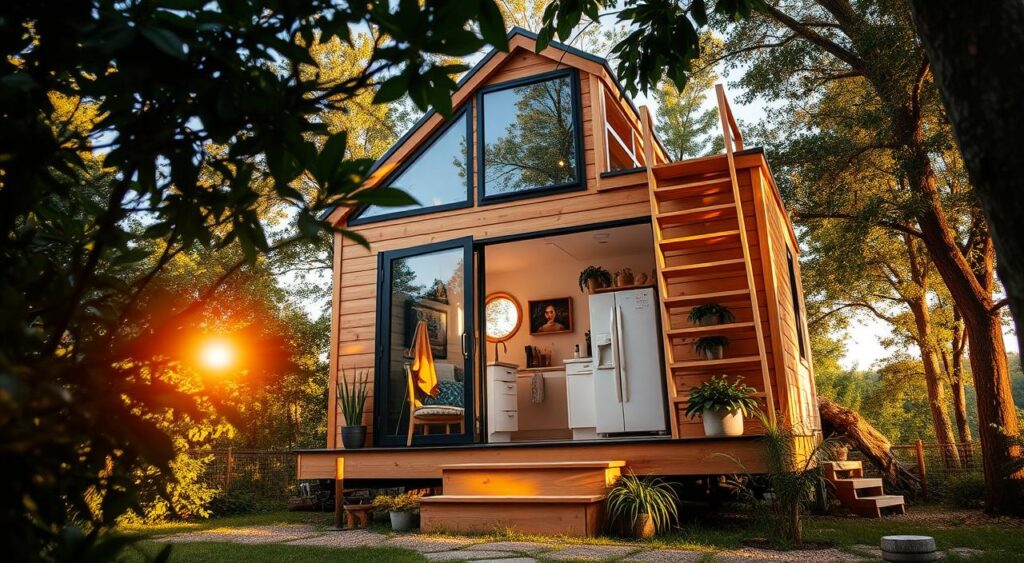
Maximizing Vertical Space
In tiny homes, using vertical space is essential. Wall-mounted storage and loft areas help keep the floor clear. This creates a sense of openness.
Loft Designs
Loft areas can add extra sleeping space or be a cozy retreat. Designing your loft with care ensures it’s useful and comfortable.
Wall Storage Systems
Wall storage systems, like shelves and cabinets, keep things organized. They use vertical space to keep your home clutter-free.
| Design Element | Purpose | Benefits |
|---|---|---|
| Open Floor Plans | Create a sense of spaciousness | Makes the home feel larger, improves natural light and ventilation |
| Multi-Functional Furniture | Serve more than one purpose | Reduces clutter, increases functionality |
| Loft Areas | Provide additional space | Creates extra sleeping or living areas, maximizes vertical space |
Step 4: Building vs. Buying Your Tiny House
Starting tiny house living means deciding to build or buy your home. This choice affects your lifestyle, budget, and happiness with your tiny house.
DIY Building Process and Requirements
Building your tiny house lets you customize it fully. But, it needs careful planning, specific skills, and lots of time. Important things to think about include:
- Assessing your construction skills and experience
- Understanding local building codes and regulations
- Planning for electrical, plumbing, and insulation needs
Be ready to pay full price for materials. Also, think about the cost of tools and possible mistakes.
Finding and Vetting Professional Tiny Home Builders
If you choose to buy, finding a good builder is key. Look for builders with:
- Experience in constructing tiny homes
- Positive customer reviews and testimonials
- Compliance with local building codes and certifications
Researching and checking out builders helps ensure you get a quality tiny home that fits your needs.
Evaluating Pre-Built and Custom Options
When buying, you can pick between pre-built and custom tiny homes. Pre-built homes are convenient and quick to move in. Custom homes offer a personalized solution. Think about your budget, timeline, and personalization needs when deciding.
Step 5: Navigating Zoning Laws and Legal Requirements
Before you set up your tiny home, you need to understand zoning laws and legal rules in your area. These laws change a lot from state to state and even within cities. It’s a complex area to explore.
Understanding Local Regulations Across States
Local rules can tell you where to put your tiny home, its size, and what kind of foundation it needs. It’s important to do your research to avoid fines or having to move. For example, some places might need your tiny home to be fixed in one place, while others might let it stay on wheels.
Securing Proper Permits and Certifications
Getting the right permits and certifications is a key step. This usually means inspections to check if your tiny home follows local building codes. Following these codes is key for living legally. It’s a good idea to talk to local officials or a professional to help you out.
Insurance and Financing Strategies
It’s also important to know about insurance and financing options. Specialized insurance for tiny homes can offer the right coverage. For financing, look into personal loans or tiny home financing programs.
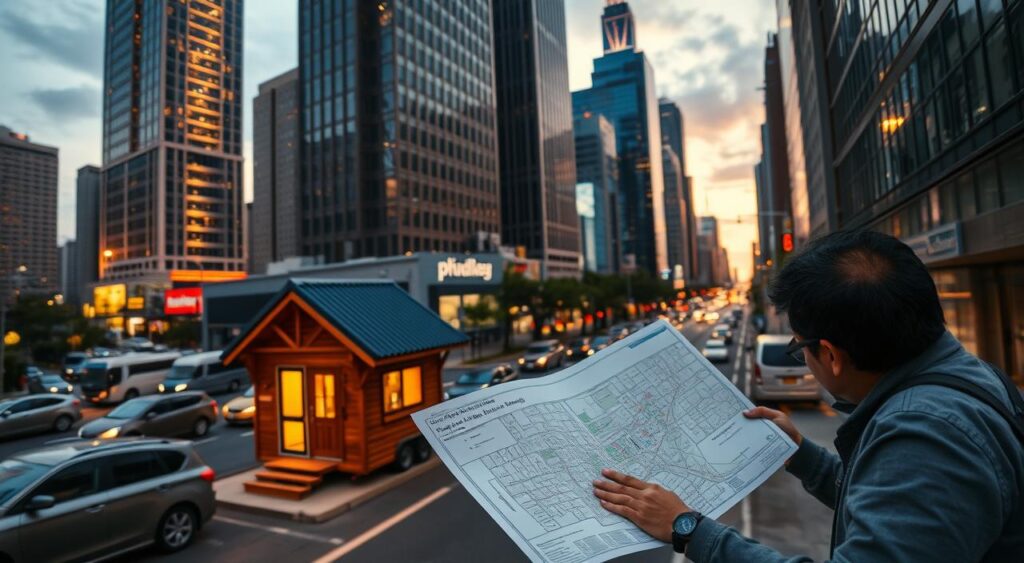
Step 6: Setting Up Essential Systems in Your Tiny Home
Essential systems are the heart of a cozy and green tiny home. As you move in, setting up these systems right is key for a smooth living experience.
Water and Plumbing Installation
Water and plumbing are essential in any home, including tiny ones. Getting them installed correctly is vital for a functional space.
On-Grid Solutions
Connecting to city water is a simple on-grid choice. It means linking your home to a water source and following local plumbing rules.
Off-Grid Alternatives
For off-grid living, you can use rainwater harvesting or water tanks. These need careful planning to meet your water needs.
Electrical Systems and Power Sources
A good electrical system is key for powering your tiny home. You can choose from:
- Grid connection for steady power
- Solar panels for green energy
- Generators for extra power
Each choice has its benefits. Pick what fits your energy use and lifestyle best.
Climate Control for All Seasons
Keeping a comfy temperature is vital in a tiny home. You can do this with:
- Insulation to keep warmth in
- Efficient heating and cooling systems
- Smart window placement for air flow
Step 7: Implementing Smart Storage Solutions
Smart storage is key to a tidy tiny home. It’s not just about having a spot for everything. It’s about using space wisely and keeping things functional. In tiny homes, every inch matters, and smart storage can greatly improve your living space.
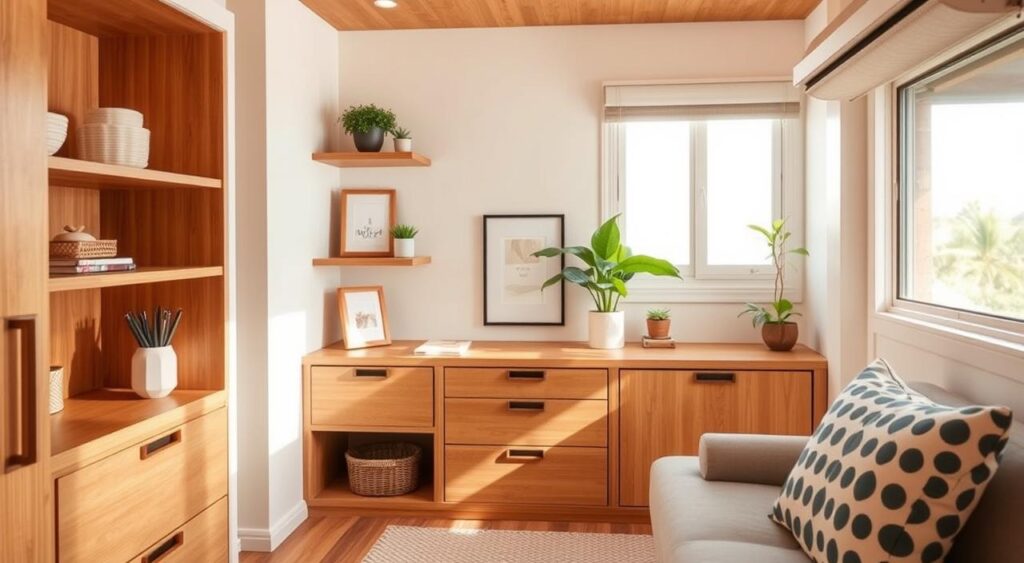
Hidden Storage Techniques
Hidden storage is a top way to make the most of tiny home space. This includes under-bed storage, hidden spots in furniture, and secret areas behind walls or under floors. By hiding items you don’t use often, you keep your home tidy and open.
For example, a bed with drawers underneath can store clothes, linens, or personal items. A sofa with hidden spots can hold books, games, or other fun stuff.
Modular and Transforming Furniture
Modular and changing furniture is a smart choice for tiny homes. These pieces can do more than one thing or change shape to fit your needs. For instance, a dining table that folds up can make more room in your home.
Modular furniture, like sectional sofas or nesting tables, lets you change your space as you want. This is perfect for tiny homes where space is limited.
Seasonal Storage Rotation Strategies
Seasonal storage helps keep tiny homes tidy. Storing items you don’t use often in labeled bins frees up space. This is great for winter clothes, holiday decorations, or sports gear.
To use this strategy well, pick a spot for seasonal storage, like under your bed or a loft. Make sure items are easy to find when you need them.
By using these smart storage ideas, tiny home dwellers can live in a neat, organized space. Creating a Pinterest board for storage ideas is a good way to plan. Save pictures of storage solutions that catch your eye and adjust them for your tiny home.
Step 8: Creating a Sustainable Tiny House Living Environment
To fully enjoy the tiny house lifestyle, it’s key to live sustainably. A sustainable tiny house not only helps the planet but also makes life better. It’s about choosing the right materials, energy sources, and water systems.
Eco-Friendly Building Materials and Insulation
Choosing the right materials is essential for a green home. Eco-friendly materials like reclaimed wood and bamboo make your home healthier. Low-VOC paints are also good for the air inside.
Good insulation keeps your tiny house cozy without needing too much heat or air conditioning. Options like recycled denim and plant-based insulation are both effective and green.
Renewable Energy Implementation
Using renewable energy sources is a big step towards a green tiny house. Solar panels are a top choice, providing clean energy. They’re perfect for tiny houses without easy access to power.
Wind turbines are also great for places with steady winds. They offer another way to generate green energy.
Water Conservation and Recycling Systems
Conserving water is vital in a tiny house. Low-flow fixtures and rainwater harvesting systems cut down water use. Greywater recycling systems reuse water for irrigation and flushing toilets, saving even more water.
Keeping chickens for food is also sustainable. It gives you fresh produce and connects you to nature and your food.
Step 9: Finding Your Tiny House Community
Starting your tiny house journey means finding a community that gets you. Connecting with others who value the same things as you can be a game-changer. It offers support, makes your journey better, and gives you a sense of belonging.
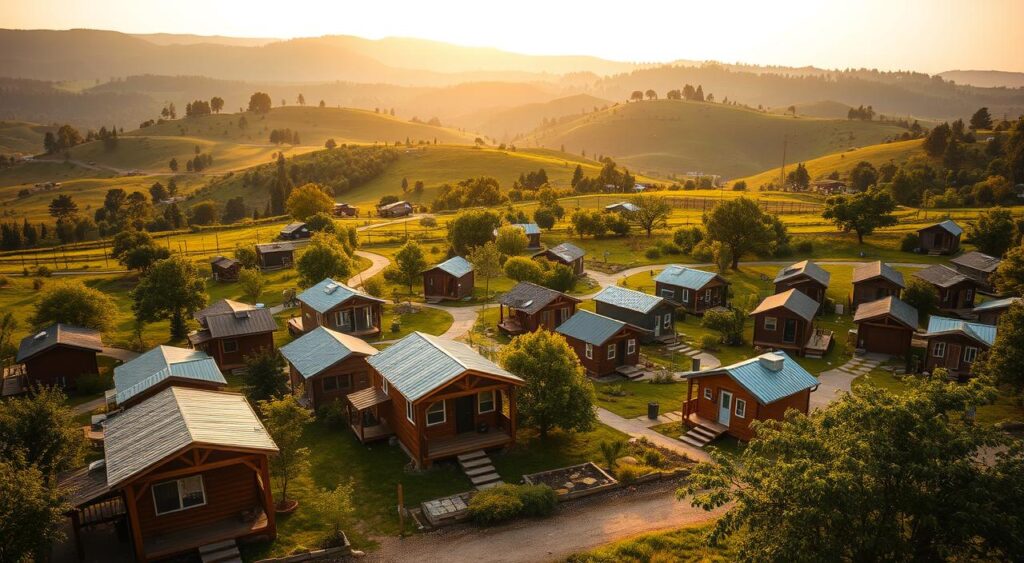
Tiny House Communities Across America
The U.S. has many tiny house communities, each with its own vibe. You can find peaceful rural spots or bustling urban areas. Researching these communities is key to finding the right fit for you.
California, Oregon, and Colorado are known for their eco-friendly living. When looking at these places, think about location, rules, and what’s available. This ensures they match your lifestyle.
Online Resources and Support Networks
Online groups and forums are also important for tiny house living. Joining tiny house Facebook groups or forums connects you with others. These places are great for sharing, getting advice, and keeping up with tiny house news.
Blogs, podcasts, and social media groups are also valuable. They offer useful info and help you feel part of a community. By joining these networks, you learn from others, discover new ideas, and find out about events.
Step 10: Adapting to Daily Life in a Tiny House
Living in a tiny house means big changes, but it can be very rewarding. You’ll need to change your daily habits, how you connect with others, and even how you host guests.
Developing New Habits and Routines
One big challenge is finding new ways to use your space wisely. This includes:
- Creating a cleaning schedule to keep your home tidy.
- Following a “one in, one out” rule to avoid clutter.
- Choosing furniture that does more than one thing.
Managing Relationships in Close Quarters
Living close to family or a partner can be tough. But, there are ways to make it work:
- Setting up your own space to keep things private.
- Talking openly about what you need and feel.
- Planning time alone or special dates together.
Entertaining and Hosting in Small Spaces
Hosting in a tiny house can be creative and fun. Think about:
- Having small, cozy dinner parties with special menus.
- Using outdoor areas for parties and barbecues.
- Getting furniture that serves more than one purpose.
By using these tips, you can make the most of your tiny house. Enjoy a simpler, more efficient way of living.
Common Challenges and Practical Solutions in Tiny House Living
Tiny house living is freeing but comes with challenges. People and families face issues like space, weather, and privacy. These problems need smart solutions.
Overcoming Space Limitations
Space is a big challenge. To solve it, tiny house dwellers use multi-functional furniture and hidden storage techniques. Beds with storage drawers and foldable kitchen tables are good examples.
Dealing with Weather Extremes
Weather is another big challenge. Tiny houses face harsh weather due to their size and mobility. Using proper insulation and weather-resistant materials helps keep it cozy inside. Climate control systems also help manage temperature.
Maintaining Privacy and Personal Space
Privacy and personal space are key, even in tiny houses. Creating separate areas helps. Using curtains or room dividers can give a sense of privacy. Henry David Thoreau said, “
The mass of men lead lives of quiet desperation.
” Tiny house living can help avoid that by focusing on what’s important.
Inspiring Success Stories: Real People Living the Tiny Dream
Many people and families are drawn to tiny house living. They seek a simpler, more meaningful life. And they find it, enjoying freedom and joy along the way.
Families Thriving in Tiny Homes
Families say tiny house living brings them closer together. The Smith family, for example, moved from a big house to a tiny one. They now spend more time together and save money.
Their kids learn about living simply and valuing experiences over stuff.
Retirees Embracing Simplified Living
Retiree couples are choosing tiny houses to simplify their lives and save money. They can travel more and enjoy hobbies on a fixed income. A couple from California, for instance, travels the country in their tiny home.
Remote Workers and Digital Nomads
Remote work has made tiny houses appealing to digital nomads. They can work from anywhere, enjoying the simplicity and flexibility. A digital nomad might work from the road or in nature, then move to a new place.
These stories show how tiny house living can improve life. It saves money, is good for the environment, and strengthens family bonds. Plus, it brings personal fulfillment.
Conclusion: Embracing the Freedom and Joy of Less
Living in a tiny house is more than downsizing. It’s about choosing a life that values freedom and joy. By living simply, people can avoid debt and help the environment.
Starting a tiny house life takes courage. It means being ready to challenge old ways. It’s about finding a path that fits your values and dreams, and starting to make them real.
When people start this journey, they find joy in living life their way. It’s not just about fewer things. It’s about finding purpose and happiness.
By following the ideas in this article, readers can start their tiny house adventure. They can find freedom and joy in a simpler, more intentional life.
